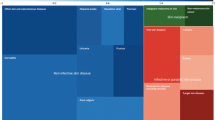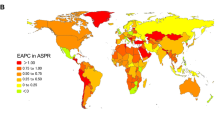Abstract
Background
Millions of people worldwide are affected by psoriasis, one of the most prevalent skin conditions. Currently, there is a lack of high-quality epidemiological reports on psoriasis.
Objective
This study aimed to reveal trends in psoriasis epidemiology in 1990–2019.
Methods
Using data from the GBD study 2019, we examined psoriasis epidemiology globally and across regions defined by the social-demographic index (SDI). Trends in incidence, prevalence, and disability-adjusted life year (DALY) rates were assessed using estimated annual percentage changes (EAPC)s. Age-period-cohort analysis examined risk variations, and decomposition analysis identified factors impacting the psoriasis burden. A Bayesian Age-Period-Cohort model predicted future incidence. Frontier analysis associated psoriasis outcomes with socio-demographic development.
Results
In 2019, the global psoriasis burden included 4,622,594 incidence, 40,805,386 prevalence, and 3,505,736 DALY cases. Despite variations in SDI regions, the overall trend showed a decline in psoriasis rates from 1990 to 2019 (EAPC = − 0.76). The age-specific analysis indicated that the highest incidence of psoriasis was observed among individuals aged 40–64 years (global, 1,606,429). Epidemiological shifts contributed negatively to global incidence and DALYs by − 80.52% and − 103.06%, respectively. Countries like San Marino and Spain displayed the highest effective differences in the decomposition analysis. By 2030, while incidence cases per 10,000 might rise (487.36, 423.62 to 551.10), age-standardized incidence rates per 100,000 were predicted to decline (53.67, 0.00 to 259.99).
Conclusion
This research revealed a global decline in psoriasis incidence rate from 1990 to 2019, with predictions suggesting this trend continues through 2030. Geographic disparities underscore the importance of tailored healthcare policies.





Similar content being viewed by others
Data availability
The data analyzed during the current study are available in the Global Burden of Disease study 2019 ( https://ghdx.healthdata.org/gbd-results-tool).
References
Boehncke W-H, Schön MP (2015) Psoriasis. Lancet 386(9997):983–994. https://doi.org/10.1016/S0140-6736(14)61909-7
Griffiths CEM, Armstrong AW, Gudjonsson JE, Barker JNWN (2021) Psoriasis. Lancet 397(10281):1301–1315. https://doi.org/10.1016/S0140-6736(20)32549-6
World Health Organization (2016) Global report on psoriasis. World Health Organization, Geneva
Michalek IM, Loring B, John SM (2017) A systematic review of worldwide epidemiology of psoriasis. J Eur Acad Dermatol Venereol 31(2):205–212. https://doi.org/10.1111/jdv.13854
Prignano F, Rogai V, Cavallucci E, Bitossi A, Hammen V, Cantini F (2018) Epidemiology of psoriasis and psoriatic arthritis in Italy-a systematic review. Curr Rheumatol Rep 20(7):43. https://doi.org/10.1007/s11926-018-0753-1
Rendon A, Schäkel K (2019) Psoriasis pathogenesis and treatment. Int J Mol Sci. https://doi.org/10.3390/ijms20061475
Petit RG, Cano A, Ortiz A, Espina M, Prat J, Muñoz M et al (2021) Psoriasis: from pathogenesis to pharmacological and nano-technological-based therapeutics. Int J Mol Sci. https://doi.org/10.3390/ijms22094983
McGeachy MJ, Cua DJ, Gaffen SL (2019) The IL-17 family of cytokines in health and disease. Immunity 50(4):892–906. https://doi.org/10.1016/j.immuni.2019.03.021
Chiricozzi A, Guttman-Yassky E, Suárez-Fariñas M, Nograles KE, Tian S, Cardinale I et al (2011) Integrative responses to IL-17 and TNF-α in human keratinocytes account for key inflammatory pathogenic circuits in psoriasis. J Invest Dermatol 131(3):677–687. https://doi.org/10.1038/jid.2010.340
Kamiya K, Kishimoto M, Sugai J, Komine M, Ohtsuki M (2019) Risk factors for the development of psoriasis. Int J Mol Sci. https://doi.org/10.3390/ijms20184347
Danielsen K, Olsen AO, Wilsgaard T, Furberg AS (2013) Is the prevalence of psoriasis increasing? A 30-year follow-up of a population-based cohort. Br J Dermatol 168(6):1303–1310. https://doi.org/10.1111/bjd.12230
Christophers E (2001) Psoriasis–epidemiology and clinical spectrum. Clin Exp Dermatol 26(4):314–320
Murray CJL (2022) The global burden of disease study at 30 years. Nat Med 28(10):2019–2026. https://doi.org/10.1038/s41591-022-01990-1
GBD 2019 Diseases and Injuries Collaborators (2020) Global burden of 369 diseases and injuries in 204 countries and territories, 1990–2019: a systematic analysis for the Global Burden of Disease Study 2019. Lancet 396(10258):1204–1222. https://doi.org/10.1016/S0140-6736(20)30925-9
Collaborators GV (2020) Five insights from the Global Burden of Disease Study 2019. Lancet 396(10258):1135–1159. https://doi.org/10.1016/S0140-6736(20)31404-5
Fitzmaurice C, Abate D, Abbasi N, Abbastabar H, Abd-Allah F, Abdel-Rahman O et al (2019) Global, regional, and national cancer incidence, mortality, years of life lost, years lived with disability, and disability-adjusted life-years for 29 cancer groups, 1990 to 2017: a systematic analysis for the global burden of disease study. JAMA Oncol 5(12):1749–1768. https://doi.org/10.1001/jamaoncol.2019.2996
GBD 2019 Diseases and Injuries Collaborators (2020) Global burden of 87 risk factors in 204 countries and territories, 1990–2019: a systematic analysis for the Global Burden of Disease Study 2019. Lancet 396(10258):1223–1249. https://doi.org/10.1016/S0140-6736(20)30752-2
Rosenberg PS, Check DP, Anderson WF (2014) A web tool for age-period-cohort analysis of cancer incidence and mortality rates. Cancer Epidemiol Biomarkers Prev 23(11):2296–2302. https://doi.org/10.1158/1055-9965.EPI-14-0300
Gupta PD (1993) Standardization and decomposition of rates: a users's manual, washington d
Ruan R, Liu X, Zhang Y, Tang M, He B, Zhang Q-W et al (2023) Global, regional, and national advances toward the management of rheumatic heart disease based on the global burden of disease study 2019. J Am Heart Assoc 12(13):e028921. https://doi.org/10.1161/JAHA.122.028921
Xie Y, Bowe B, Mokdad AH, Xian H, Yan Y, Li T et al (2018) Analysis of the Global Burden of Disease study highlights the global, regional, and national trends of chronic kidney disease epidemiology from 1990 to 2016. Kidney Int 94(3):567–581. https://doi.org/10.1016/j.kint.2018.04.011
Parisi R, Iskandar IYK, Kontopantelis E, Augustin M, Griffiths CEM, Ashcroft DM (2020) National, regional, and worldwide epidemiology of psoriasis: systematic analysis and modelling study. BMJ 369:m1590. https://doi.org/10.1136/bmj.m1590
Enamandram M, Kimball AB (2013) Psoriasis epidemiology: the interplay of genes and the environment. J Invest Dermatol 133(2):287–289. https://doi.org/10.1038/jid.2012.434
Kurd SK, Gelfand JM (2009) The prevalence of previously diagnosed and undiagnosed psoriasis in US adults: results from NHANES 2003–2004. J Am Acad Dermatol 60(2):218–224. https://doi.org/10.1016/j.jaad.2008.09.022
Lima XT, Minnillo R, Spencer JM, Kimball AB (2013) Psoriasis prevalence among the 2009 AAD National Melanoma/Skin Cancer Screening Program participants. J Eur Acad Dermatol Venereol 27(6):680–685. https://doi.org/10.1111/j.1468-3083.2012.04531.x
Li R, Sun J, Ren L-M, Wang H-Y, Liu W-H, Zhang X-W et al (2012) Epidemiology of eight common rheumatic diseases in China: a large-scale cross-sectional survey in Beijing. Rheumatology (Oxford) 51(4):721–729. https://doi.org/10.1093/rheumatology/ker370
Parisi R, Symmons DPM, Griffiths CEM, Ashcroft DM (2013) Global epidemiology of psoriasis: a systematic review of incidence and prevalence. J Invest Dermatol 133(2):377–385. https://doi.org/10.1038/jid.2012.339
Iskandar IYK, Parisi R, Griffiths CEM, Ashcroft DM (2021) Systematic review examining changes over time and variation in the incidence and prevalence of psoriasis by age and gender. Br J Dermatol 184(2):243–258. https://doi.org/10.1111/bjd.19169
Henseler T, Christophers E (1985) Psoriasis of early and late onset: characterization of two types of psoriasis vulgaris. J Am Acad Dermatol 13(3):450–456
Chen C, Che K, Guo Y, Huang Q, Hu X, Yu B (2023) Effect of the age of onset on epidemiology, clinical features, and comorbidity of geriatric psoriasis. J Dermatol 50(9):1156–1161. https://doi.org/10.1111/1346-8138.16856
Patrick MT, Li Q, Wasikowski R, Mehta N, Gudjonsson JE, Elder JT et al (2022) Shared genetic risk factors and causal association between psoriasis and coronary artery disease. Nat Commun 13(1):6565. https://doi.org/10.1038/s41467-022-34323-4
Yamazaki F (2021) Psoriasis: comorbidities. J Dermatol 48(6):732–740. https://doi.org/10.1111/1346-8138.1584
Greb JE, Goldminz AM, Elder JT, Lebwohl MG, Gladman DD, Wu JJ et al (2016) Psoriasis. Nat Rev Dis Primers 2:16082. https://doi.org/10.1038/nrdp.2016.82
Abuabara K, Azfar RS, Shin DB, Neimann AL, Troxel AB, Gelfand JM (2010) Cause-specific mortality in patients with severe psoriasis: a population-based cohort study in the U.K. Br J Dermatol 163(3):586–592. https://doi.org/10.1111/j.1365-2133.2010.09941.x
Kaushik SB, Lebwohl MG (2019) Psoriasis: Which therapy for which patient: psoriasis comorbidities and preferred systemic agents. J Am Acad Dermatol 80(1):27–40. https://doi.org/10.1016/j.jaad.2018.06.057
Springate DA, Parisi R, Kontopantelis E, Reeves D, Griffiths CEM, Ashcroft DM (2017) Incidence, prevalence and mortality of patients with psoriasis: a U.K. population-based cohort study. Br J Dermatol 176(3):650–658. https://doi.org/10.1111/bjd.15021
Kubota K, Kamijima Y, Sato T, Ooba N, Koide D, Iizuka H et al (2015) Epidemiology of psoriasis and palmoplantar pustulosis: a nationwide study using the Japanese national claims database. BMJ Open 5(1):e006450. https://doi.org/10.1136/bmjopen-2014-006450
Rachakonda TD, Schupp CW, Armstrong AW (2014) Psoriasis prevalence among adults in the United States. J Am Acad Dermatol 70(3):512–516. https://doi.org/10.1016/j.jaad.2013.11.013
Acknowledgements
Thanks to Xiao Ming (Xiaoming_room@hotmail.com) for his work on the GBD database. His excellent sharing of the GBD database analysis procedure and other public databases makes it easier for us to explore the GBD database.
Funding
The research was conducted without financial support.
Author information
Authors and Affiliations
Contributions
Conceptualization: KW, XC; Data Curation: KW; Formal analysis: KW; Investigation: KW; Methodology: KW, XC; Writing—original draft: KW; Writing—review & editing: YZ, XC; Funding acquisition: YZ; Project administration: YZ; Resources: XC; Supervision: YZ.
Corresponding authors
Ethics declarations
Competing interests
The authors declare no competing interests.
Conflicts of interest
The authors declare that they have no conflict of interest.
Informed consent
This study did not require informed consent as it did not involve human subjects.
Additional information
Publisher's Note
Springer Nature remains neutral with regard to jurisdictional claims in published maps and institutional affiliations.
Supplementary Information
Below is the link to the electronic supplementary material.
Rights and permissions
Springer Nature or its licensor (e.g. a society or other partner) holds exclusive rights to this article under a publishing agreement with the author(s) or other rightsholder(s); author self-archiving of the accepted manuscript version of this article is solely governed by the terms of such publishing agreement and applicable law.
About this article
Cite this article
Wang, K., Zhao, Y. & Cao, X. Global burden and future trends in psoriasis epidemiology: insights from the global burden of disease study 2019 and predictions to 2030. Arch Dermatol Res 316, 114 (2024). https://doi.org/10.1007/s00403-024-02846-z
Received:
Revised:
Accepted:
Published:
DOI: https://doi.org/10.1007/s00403-024-02846-z




